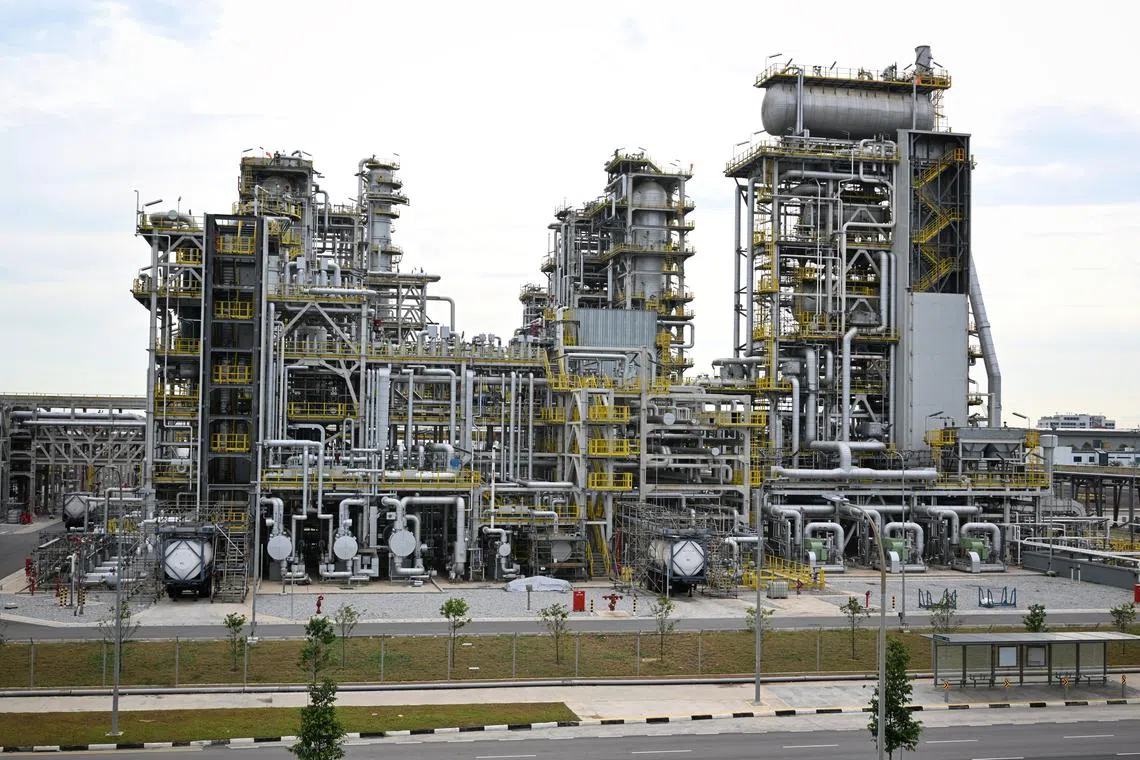Iata to set up sustainable aviation fuel registry as production set to triple in 2024
Sign up now: Get ST's newsletters delivered to your inbox

Neste’s refinery in Tuas South is the world’s largest production facility producing sustainable aviation fuel from used cooking oils and animal fats.
PHOTO: ST FILE
Follow topic:
DUBAI - The International Air Transport Association (Iata) aims to launch a sustainable aviation fuel (SAF) registry by the first quarter of 2025, to accelerate the take-up of SAF by accounting for usage and reporting emissions reduction from it.
Announcing the registry on June 2 at the start of its three-day annual meeting in Dubai, Iata said the registry will ensure that the environmental attributes of SAF are properly recorded and transferred between parties.
This will allow airlines and their customers to report emissions reduction accurately, aligning with reporting obligations and international standards, it added.
Iata said 17 airlines, one airline group, six national authorities, three original equipment manufacturers and one fuel producer are supporting the effort to develop the registry, including the Civil Aviation Authority of Singapore (CAAS) and Singapore Airlines.
The planned registry comes as the association said its projections for a tripling of SAF production
SAF is expected to account for up to 65 per cent of the total carbon mitigation needed to achieve net-zero carbon emissions in air transportation by 2050.
“The SAF registry will help meet the critical needs of all stakeholders as part of the global effort to ramp up SAF production.
“Governments need a trusted system to track the quality and quantities of SAF used. SAF producers need to accurately account for what has been delivered and effectively decarbonised,” said Iata director general Willie Walsh.
He noted that corporate customers must be able to transparently account for their Scope 3 emissions – or indirect emissions arising from a company’s supply chain – while airlines must have certainty that they can claim the environmental benefits of the SAF they purchase.
“The registry will help create a global SAF market by ensuring that airlines have access to SAF wherever it is produced, and that SAF producers have access to airlines regardless of their location,” he added.
Iata said the registry will help airlines meet regulations such as the Carbon Offsetting and Reduction Scheme for International Aviation, ensuring compliance with SAF mandates and providing transparency on emissions reductions to the authorities.
It will provide safeguards against double counting and double claiming, the association added.
Dr Marie Owens Thomsen, Iata’s senior vice-president for sustainability and chief economist, told The Straits Times that the association is grateful to both SIA and CAAS for their support and help in developing the registry.
“Nobody has done this – decarbonise aviation and the market for SAF doesn’t really exist yet... It is very courageous of them to take these steps, and I am convinced that Singapore is a country where the results of the policies will be analysed, and if they turn out to be not as good as hoped, change will occur,” she said.
“Creating this global SAF market is a work in progress, and different countries are trying different things... The oil and gas sector could be co-processing. They could try to adjust the product mix in refineries to make more sustainable aviation fuel.
“We need to deprioritise diesel and prioritise SAF... and turn refineries into biorefineries that produce more aviation fuel,” she added.
To achieve a 5 per cent reduction in carbon emissions for international aviation from SAF by 2030, around 27 per cent of all expected renewable fuel production capacity available in 2030 would need to be SAF. Currently, SAF accounts for just 3 per cent of all renewable fuel production.
There are several potential solutions to accelerate aviation’s access to SAF, the association said.
About 80 per cent of SAF to be produced over the next five years is likely to come from hydrogenated fatty acids – used cooking oils and animal fats. Finnish energy giant Neste’s refinery in Tuas South is the world’s largest production facility producing sustainable aviation fuel
Accelerating the use of other feedstock including agricultural and forestry residues and municipal waste will expand the potential for SAF production, Iata noted.
“Existing refineries can be used to co-process up to 5 per cent of approved renewable feedstock alongside the crude oil streams,” Iata said.
The association noted that current renewable fuel plants are designed to maximise diesel production and often benefit from incentives as well as demand from road transportation.
“Incentives aimed at SAF can help facilitate the renewable diesel-SAF switch, which requires minimal modifications at existing standalone renewable fuel facilities,” Iata said.
Some 140 renewable fuel projects have been announced. If these proceed to production, total renewable fuel production capacity could reach 51 million tonnes by 2030.


